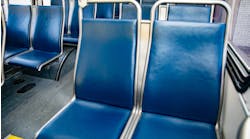Flooring That Moves With Mass Transit
Public transportation is a popular and convenient means of travel in many large cities. Millions of commuters across the country rely on mass transit to get them reliably and safely to their destination. On the environmental front, a recent study conducted by the New Jersey Institute of Technology found that public transportation can reduce harmful CO2 emissions by 37 million metric tons annually. Using mass transit can also save households an average of $6,251 every year and reduce gasoline dependence by 4.2 billion gallons annually.
Transportation pioneers like Elon Musk have grand visions for the future of transportation. Their aim is to get travelers to their destination faster and safer, while further reducing energy consumption. However, as mass transit becomes increasingly popular, riders demand more amenities to enhance their travel experience. City officials are looking for new and innovative ways to design public transportation systems that are not only comfortable for commuters, but also durable and sustainable enough to stand up to a burgeoning ridership.
Materials specified for new construction or renovation of mass transportation can have a significant impact on passengers as well as the lifespan of its cars or vehicles. Selecting materials such as premium rubber flooring can help meet the demands of mass transit while maintaining a like-new aesthetic for years to come. Here’s a closer look at why premium rubber is an ideal choice for public transportation applications.
Safety in Numbers
According to the National Public Transportation Association, mass transit is one of the safest ways to travel – citing it is ten times safer per mile than traveling by car, because it has less than a tenth of the per-mile traffic casualty (injury or death) rate as automobile travel.
Flooring can play a key role in mass transit safety. Mud, snow and rain brought into buses, subways or trains can cause floors to become slippery. This hazard is compounded by commuters rushing to get to their destination. In fact, some of the most common injuries occur from falls due to slipping on unreliable floors. Waterproof premium rubber is designed to withstand the harshest conditions while keeping passengers on their feet.
In the event of a fire, it is not only the spread of flames, but the buildup of smoke and gas that poses a great danger to passengers. Many floor covering coatings burn easily and contain substances that release hazardous gases if burned. Premium rubber floor coverings are highly flame-retardant and free of PVCs and halogens. In the event of a fire, no hydrogen chloride is formed which could lead to respiratory tract burns.
Clean Air Commute
The Federal Transit Administration states public transportation helps cities improve national air quality standards by reducing the level of vehicle emissions and pollutants. Some types of flooring have finishes that release toxic emissions which can be harmful to passengers and may eventually lead to health issues (headaches, discomfort, respiratory issues). Premium rubber floors are both low-emission and low-pollutant. Made from mostly natural materials and containing no PVC, phthalates or other plasticizers, premium rubber actually helps improve indoor air quality.
Premium rubber floor coverings have third-party low VOC emissions and certifications from numerous organizations throughout the world including The Blue Angel (products and services that have environmentally friendly aspects) and GREENGUARD Gold (products that let out extremely low levels of emissions, including formaldehyde).
Standing up for Comfort
Long commutes can put passengers on their feet for great lengths of time, which can ultimately result in musculoskeletal disorders and lost time from work. While many flooring materials are hard and unforgiving, premium rubber has a unique crosslinking of materials that provides superior ergonomics and comfort underfoot. Unlike most floor coverings, premium rubber is made of resilient material that eases the stress of walking and standing.
Riders also need to be able to move across floors with confidence. Coating-free premium rubber offers verified nonslip properties to improve the safety of its surroundings. It also helps reduce confusion and disorientation from reflective or overly smooth surfaces, which can deliver a “perception of slipperiness.”
Operational Optimization
Much like the cities they serve, mass transit systems are always on the go, leaving little downtime to clean and maintain them. Fortunately, the cleaning protocol for premium rubber requires little more than water and a mop. Its uncoated, dense, non-porous surface eliminates the need for harsh cleaning agents and stripping and waxing.
Chemicals and special equipment make cleaning both complex and costly – impacting operational optimization and efficiency. Considering approximately 90 percent of the cost of a floor comes from ongoing care and maintenance, premium rubber can greatly reduce the total cost of ownership over its lifespan. Premium rubber can last up to 50 years, so floors may never need to be replaced.
Design with Purpose
Flooring in public transportation should be more than just durable – it should also provide guidance and information to passengers. Wayfinding techniques, such as directional flooring lines, help riders safely navigate to their intended destination. Clear symbols for wheelchairs, bicycles, suitcases or baby carriages help provide passengers with a quick overview of designated areas. Safety symbols also make it easier for passengers to find their way around quickly, regardless of language.
Modern ultrasonic cutting machines allow premium rubber flooring to be produced in any shape, symbol or wayfinding system design – down to the millimeter. The exceptional dimensional stability of premium rubber means each inlay can be installed seamlessly. Symbols are firmly anchored in the floor to protect against vandalism or damage from wear and tear. Thanks to precision cutting and incorporation into the floor covering, indicators last significantly longer than signs or stickers.
Future of Transportation. Future of Flooring.
According to a 2014 United Nations Report, 54 percent of the world's population resides in urban areas. By 2050, that number is expected to rise to 66 percent. This, in turn, will lead to additional need for mass transit to help avoid traffic congestion, rising commuter times and the impact of emissions and greenhouse gases on global warming.
Fortunately, premium rubber flooring is up to the challenge. It can be found in public transit systems around the world – from subways to trains to busses and beyond – proving that it is the superior choice for the global transportation industry.




